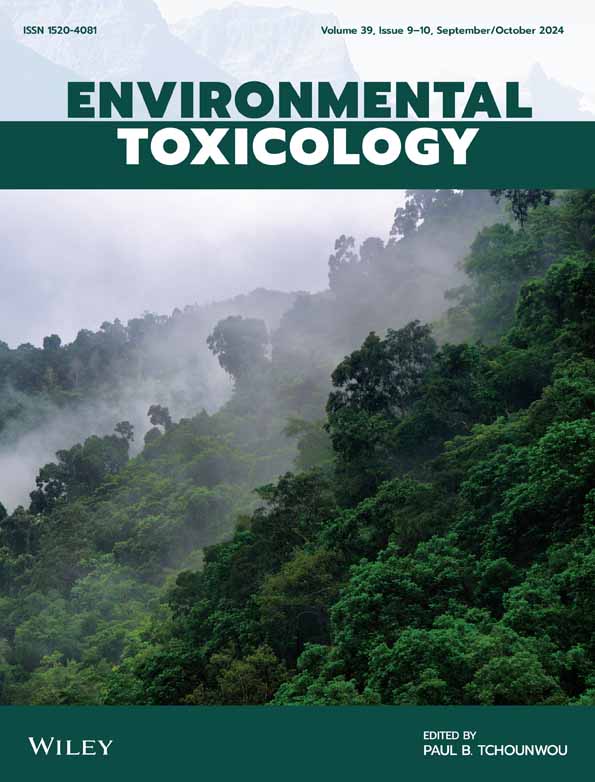对羟基苯甲酸甲酯和对羟基苯甲酸丙酯对大蒜根尖的细胞毒性和基因毒性比较
IF 3.2
3区 医学
Q2 ENVIRONMENTAL SCIENCES
引用次数: 0
摘要
对羟基苯甲酸酯(PBs)是对羟基苯甲酸的烷基酯,由于其抗菌特性而广泛应用于制药、食品、饮料和化妆品中。对羟基苯甲酸酯也被称为“内分泌干扰物”,可以对不同的生物体造成毒性。对羟基苯甲酸酯,特别是对羟基苯甲酸甲酯和对羟基苯甲酸丙酯也存在于许多环境基质中,如水源和土壤,并可对不同的生物体造成细胞毒性和遗传毒性作用。本研究旨在通过彗星试验和基于细胞学异常的评估,评估两种最常用的对羟基苯甲酸甲酯和对羟基苯甲酸丙酯对洋葱根尖分生细胞的遗传毒性和细胞毒性作用。根生长抑制试验评价根生长抑制作用。A. cepa法测定有丝分裂指数(MI)和染色体畸变(CAs)。采用彗星法评估DNA损伤。对羟基苯甲酸甲酯和对羟基苯甲酸丙酯对A. cepa细胞生长的半最大有效浓度(EC50)分别为75 ug/mL(2.70±0.10 cm)和25 ug/mL(2.70±0.2 cm)。同样,在暴露于对羟基苯甲酸甲酯和对羟基苯甲酸丙酯24小时和48小时后,观察到cepa根尖有丝分裂指数(MI)的剂量和时间依赖性降低,染色体畸变(CAs)的增加和DNA损伤的增加。研究结果表明,与对羟基苯甲酸甲酯相比,对羟基苯甲酸丙酯比对羟基苯甲酸甲酯具有更大的细胞毒性和基因毒性,这一点可以从心肌梗死的显著降低、染色体畸变和DNA损伤的增加等方面得到证明。本文章由计算机程序翻译,如有差异,请以英文原文为准。
Comparative Cytotoxic and Genotoxic Assessment of Methylparaben and Propylparaben on Allium cepa Root Tips by Comet and Allium cepa Assays
Parabens (PBs) are alkyl esters of para‐hydroxybenzoic acid and are widely used in pharmaceuticals, food and beverages, and cosmetics due to their antimicrobial properties. Parabens are also known as “Endocrine disruptors” and can cause toxicity in different organisms. Parabens, especially methylparaben and propylparaben are also present in many environmental matrices, such as water sources and soil, and can cause cytotoxic and genotoxic effects in different organisms. This study aimed to evaluate the genotoxic and cytotoxic effects of the two most commonly used types of parabens that are methylparaben and propylparaben on meristematic cells in onion root tips by comet assay and cytological anomaly‐based evaluation. Root growth inhibition assay was used to evaluate root growth inhibition. A. cepa 50 ) on the growth of A. cepa A. cepa
求助全文
通过发布文献求助,成功后即可免费获取论文全文。
去求助
来源期刊

Environmental Toxicology
环境科学-毒理学
CiteScore
7.10
自引率
8.90%
发文量
261
审稿时长
4.5 months
期刊介绍:
The journal publishes in the areas of toxicity and toxicology of environmental pollutants in air, dust, sediment, soil and water, and natural toxins in the environment.Of particular interest are:
Toxic or biologically disruptive impacts of anthropogenic chemicals such as pharmaceuticals, industrial organics, agricultural chemicals, and by-products such as chlorinated compounds from water disinfection and waste incineration;
Natural toxins and their impacts;
Biotransformation and metabolism of toxigenic compounds, food chains for toxin accumulation or biodegradation;
Assays of toxicity, endocrine disruption, mutagenicity, carcinogenicity, ecosystem impact and health hazard;
Environmental and public health risk assessment, environmental guidelines, environmental policy for toxicants.
 求助内容:
求助内容: 应助结果提醒方式:
应助结果提醒方式:


